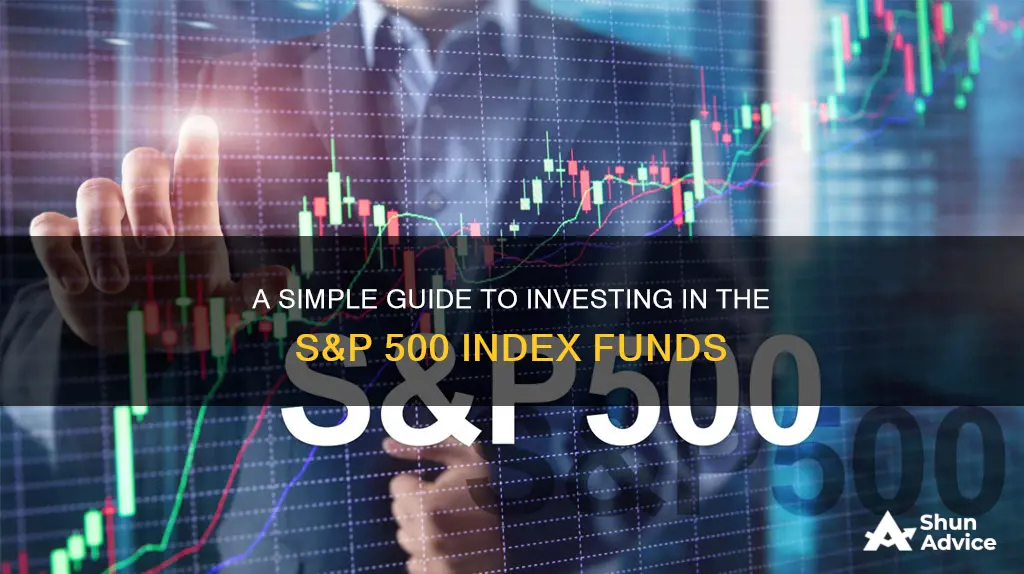
The S&P 500 is a stock market index composed of about 500 large, leading public U.S. companies. It is one of the stock market indexes often considered a proxy for the overall health of the U.S. stock market.
You cannot directly invest in the index itself, but you can buy an S&P 500 index fund or exchange-traded fund (ETF) that tracks the index. These funds aim to replicate the returns of the S&P 500 by offering investors exposure to the companies within the index without the effort of purchasing individual stocks.
Investing in an S&P 500 fund can instantly diversify your portfolio and is generally considered less risky than purchasing individual stocks directly. You can purchase index funds and ETFs in a taxable brokerage account, or if you're investing for retirement, in a 401(k) or IRA, which come with added tax benefits.
| Characteristics | Values |
|---|---|
| Number of companies | 500 large public U.S. companies |
| Index funds expense ratio | 0.03% to 0.10% |
| ETFs expense ratio | 0.03% |
| Index funds minimum investment | $3,000 |
| ETFs minimum investment | $500-$650 |
| Index funds with no minimum investment | Any dollar amount |
| Average annual return | 10% |
What You'll Learn

What is the S&P 500?
The S&P 500, or Standard and Poor's 500, is a stock market index that tracks the stock performance of around 500 of the largest companies listed on US stock exchanges. It is one of the most widely followed equity indices and includes about 80% of the total market capitalisation of US public companies, with a total market cap of over $43 trillion as of January 2024.
The S&P 500 is a weighted index, with each company given a specific weighting obtained by dividing the company's market cap (the total value of its outstanding shares) by the S&P 500's total market cap. The index's value is calculated based on the market cap of each company, with adjustments made for the number of shares traded publicly. The larger the company, the more impact it has on the index.
The S&P 500 is considered a bellwether for the American stock market, and when investors talk about "beating the market", this index is often used as the benchmark. It is synonymous with the market itself, and its performance is used to gauge the health of the US stock market and the broader economy.
The index includes stocks across all 11 sectors of the economy, as defined by the GICS classification system. These sectors are: Information Technology, Financials, Healthcare, Consumer Discretionary, Industrials, Communication Services, Consumer Staples, Energy, Utilities, Real Estate, and Materials.
The S&P 500 is maintained by S&P Dow Jones Indices, a joint venture majority-owned by S&P Global, and its components are selected by a committee. Companies must meet certain criteria to be included in the index, such as having a market capitalisation of at least $15.8 billion (as of 2024), being based in the US, and being listed on an eligible US exchange.
The index was first launched in 1957 and has since become one of the most popular investments, offering average annual returns of about 10%. It provides a diversified exposure to some of the world's most dynamic companies, including well-known names like Microsoft, Apple, Amazon, and Meta Platforms.
Individuals can invest in the S&P 500 through index funds or ETFs that track the index. These funds aim to replicate the performance of the index by holding the same stocks in the same proportions. Some of the most popular index funds that track the S&P 500 include Vanguard 500 Index Investor Shares (VFINX) and Fidelity 500 Index Fund (FXAIX).
Pension Funds: Choosing the Right Investment for Your Future
You may want to see also

How to choose an S&P 500 index fund
The S&P 500 index is a bellwether for the American stock market, containing about 500 of the largest companies in the United States. S&P 500 index funds are a very popular investment choice, as they allow investors to own the market instead of trying to beat it.
Expense Ratio
The expense ratio is the cost that the fund manager will charge you over the course of a year to manage the fund, expressed as a percentage of your investment. As index funds are passively managed, expense ratios should be relatively low. Since all S&P 500 index funds perform similarly, the fees you pay become a crucial factor when selecting a fund. Many S&P 500 index funds charge less than 0.10% annually, which means you'll pay only $10 per year for every $10,000 invested.
Sales Load
If you're investing in mutual funds, check if the fund manager charges a sales load, which is a sales commission. You should avoid this expense, especially when buying an index fund. ETFs do not charge a sales load.
Minimum Investment
S&P 500 index funds have different minimum investment requirements for taxable investment accounts and IRAs. Ensure that the fund you choose aligns with the amount you have to invest initially and that you can purchase additional shares in intervals that fit your budget. Some funds, like Fidelity and Schwab, offer their index funds with no minimum investment, making them very accessible to beginner investors. Others, like Vanguard, have a relatively low minimum investment of $3,000.
Dividend Yield
Compare the dividend yield between index funds, as dividends can boost returns even in down markets.
Inception Date
If you prefer to see a solid track record before investing, pay attention to the fund's inception date. Funds with longer histories can show you how the fund performed during bull and bear markets.
Diversification
The S&P 500 index funds allow you to hold a stake in hundreds of stocks, even if you own just one share of the fund. This broad collection of companies helps to lower your risk through diversification.
Performance
Over the long term, the S&P 500 has historically returned about 10% annually on average. However, any investment can produce poor returns if purchased at overvalued prices. Consider using dollar-cost averaging to spread out your buy points and avoid timing the market.
Other Considerations
- You only need one S&P 500 index fund in your portfolio, as they post broadly similar returns.
- You can invest in the S&P 500 through a brokerage account, an individual retirement account (IRA), or a 401(k).
- S&P 500 index funds are low-cost investments, and your returns will mirror the index's returns over the long term.
- The S&P 500 has a flawless track record of delivering profits over long holding periods.
Index Funds: A Smart Investment Strategy for Long-Term Wealth
You may want to see also

How to invest in the S&P 500 from the UK
The S&P 500 is a stock index that tracks the performance of 500 leading US companies. It is considered a bellwether for the US stock market and the broader US economy. The index includes some of the world's most well-known companies, such as Apple, Microsoft, Amazon, and Google.
There are two main ways to invest in the S&P 500 from the UK:
- Buy shares in all 500 companies: This option can be time-consuming and expensive as you need to constantly update your portfolio to match the index.
- Invest in an S&P 500 fund or Exchange-Traded Fund (ETF): This is the preferred option as it saves time and money. Someone else manages the fund for you, and all you need to do is choose one to invest in. Here's how:
- Find an S&P 500 index fund or ETF: Compare funds based on their ongoing fees, which are measured by the Total Expense Ratio (TER). The Invesco S&P 500 UCITS ETF is an example of a low-cost fund with a TER of 0.05%.
- Open a share dealing account: Look for an investment account or brokerage that offers S&P 500 index funds. Some funds may only be available on certain platforms.
- Top up your account: Deposit funds into your account. Be mindful of any deposit fees and foreign exchange fees if your base currency is not USD.
- Buy the S&P 500 fund: Once your money is deposited, purchase your chosen S&P 500 index fund. You'll typically pay a small annual fee for investing in an ETF or index fund.
- Hargreaves Lansdown: Offers the Vanguard S&P 500 UCITS ETF.
- Fidelity: Offers the iShares Core S&P 500 ETF and the Fidelity 500 Index Fund.
- EToro: Offers the ability to invest in S&P500, NASDAQ100, FTSE100, and other leading indices.
Remember, investing in the S&P 500 provides exposure to US stocks only. To diversify your portfolio, consider investing in other global indices such as the FTSE 100, Nikkei 225, or Dax.
Best Banks for Investment: Where to Invest Your Money?
You may want to see also

What are the main sectors covered by the S&P 500?
The S&P 500 index fund is a passive investment strategy that tracks the performance of 500 large US companies, chosen based on market capitalization, sector allocation, and liquidity. As of April 2024, the three sectors with the largest concentration of companies in the S&P 500 were:
- Information Technology (29.2%)
- Financials (13.1%)
- Healthcare (12.3%)
The S&P 500 index covers 11 distinct sectors in total, which are:
- Communication Services
- Consumer Discretionary
- Consumer Staples
- Energy
- Financials
- Healthcare
- Industrials
- Information Technology
- Materials
- Real Estate
- Utilities
These sectors can be further broken down into 126 industries, such as semiconductors, biotechnology, and aerospace and defence.
Mutual Funds: Best Month to Invest and Maximize Returns
You may want to see also

How much does it cost to invest in the S&P 500?
The cost of investing in the S&P 500 depends on the type of fund you choose. If you opt for an S&P 500 index fund, there may be a minimum investment amount required, and you'll be charged an expense ratio as an annual fee. The expense ratio is expressed as a percentage of your investment, so if the expense ratio is 0.04% and you invest $100, you'll pay an annual fee of $0.04. Some popular S&P 500 index funds have expense ratios as low as 0.03%-0.04%.
On the other hand, if you choose to invest in an S&P 500 ETF, you'll need to consider the share price. Depending on your broker, you may be able to buy fractional shares for any dollar amount, or you may need to pay the full share price. ETFs also often have expense ratios, so be sure to factor that into your decision.
Another option is to invest in individual stocks within the S&P 500. Stock costs can vary significantly, with some stocks costing under $100 and others costing $500 or more per share.
It's worth noting that S&P 500 index funds and ETFs are typically low-cost investment options due to their passive management structure.
Pension Funds: Equities for Long-term Growth and Diversification
You may want to see also
Frequently asked questions
The S&P 500 Index is a stock market index composed of about 500 large public U.S. companies. It is one of the stock market indexes often considered a proxy for the overall health of the U.S. stock market.
You can invest in the S&P 500 by purchasing shares of a mutual fund or exchange-traded fund (ETF) that tracks the index. You can also buy individual stocks of companies within the index.
Investing in the S&P 500 provides instant diversification to your portfolio and is generally considered less risky than purchasing individual stocks directly. The index has returned about 10% per year on average over the long term.







